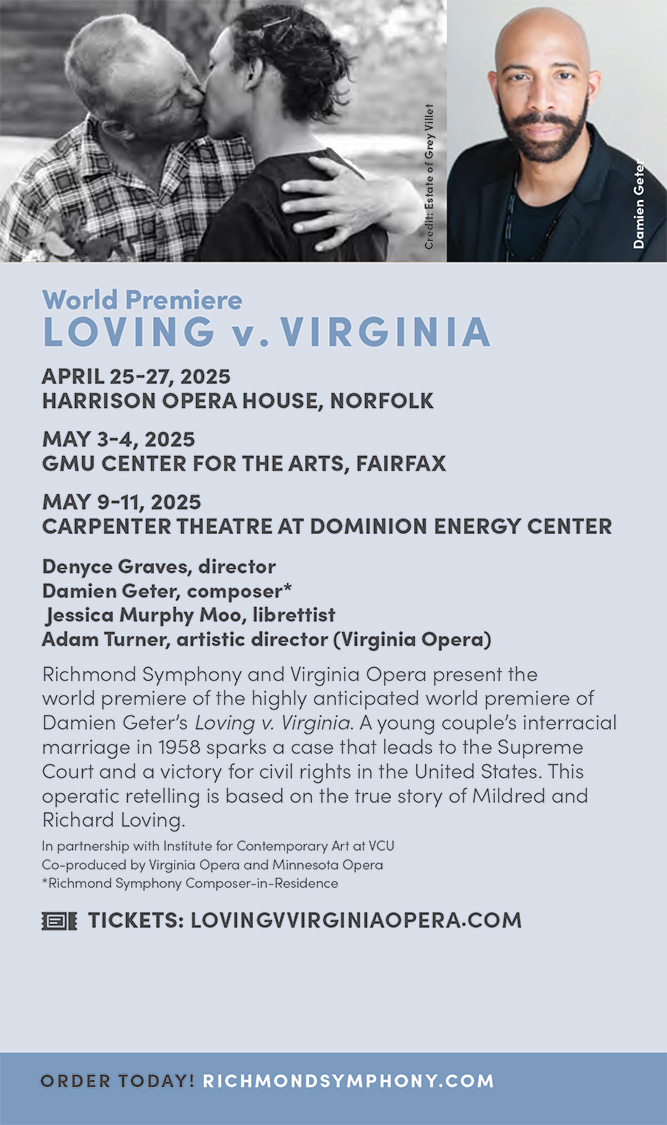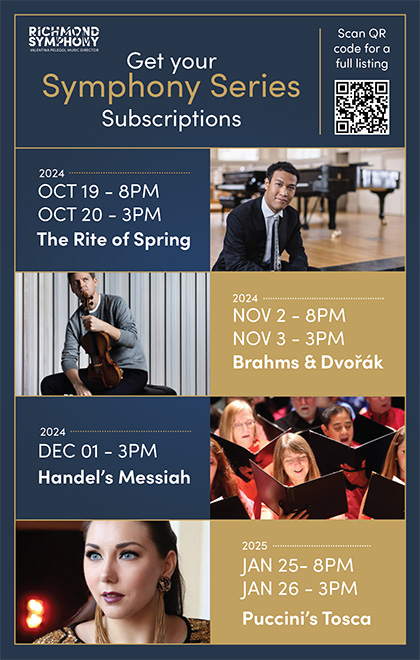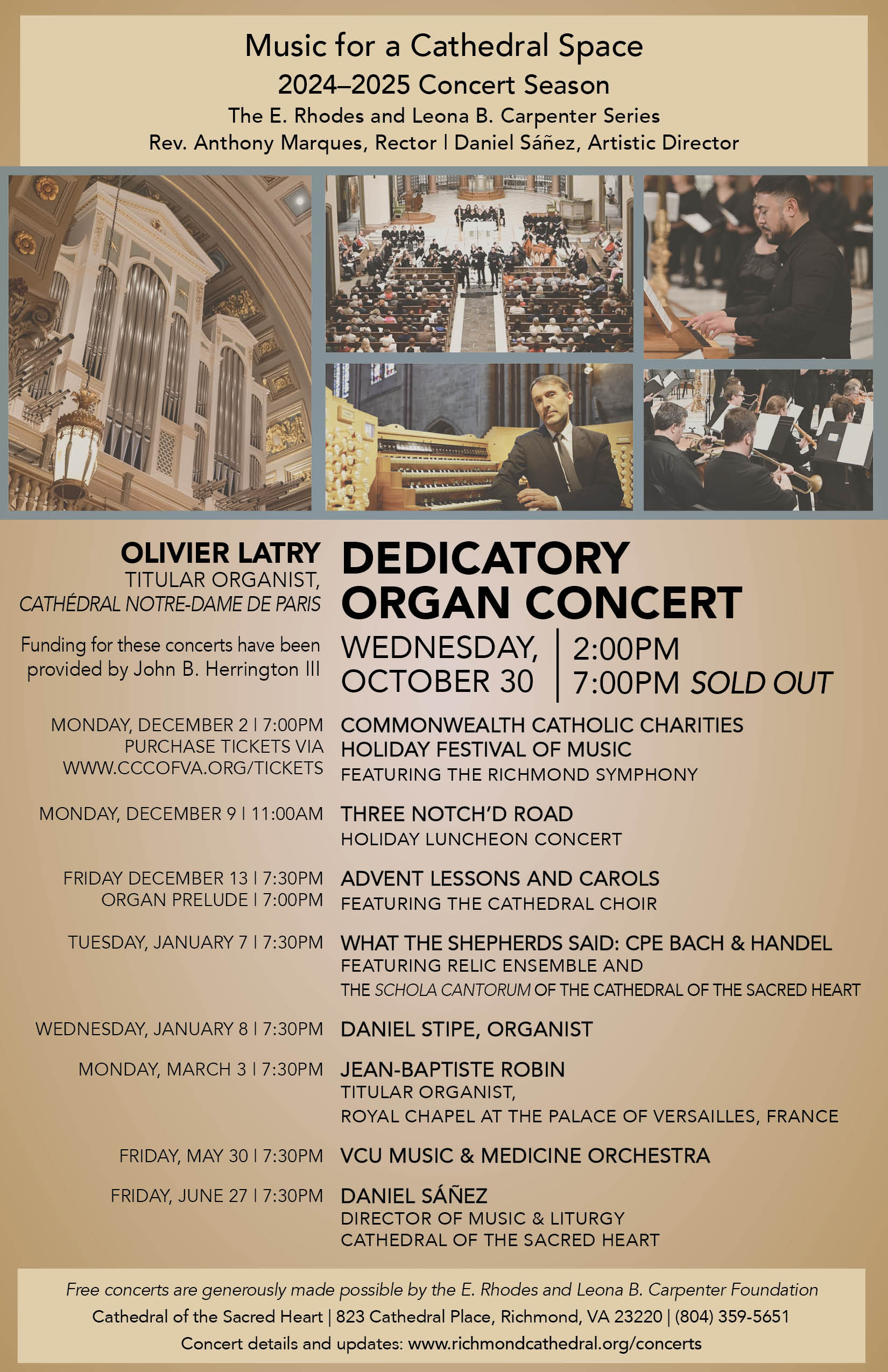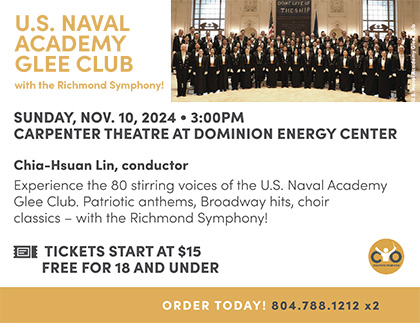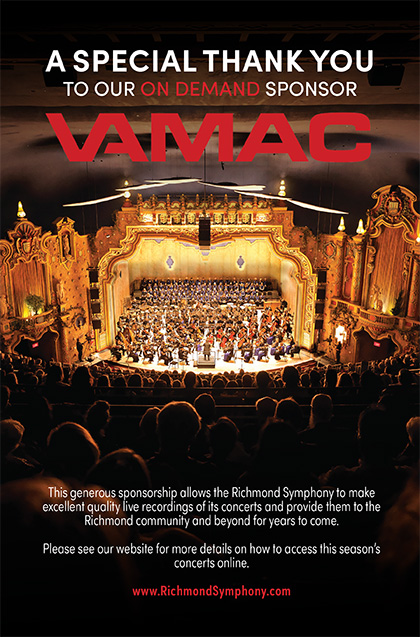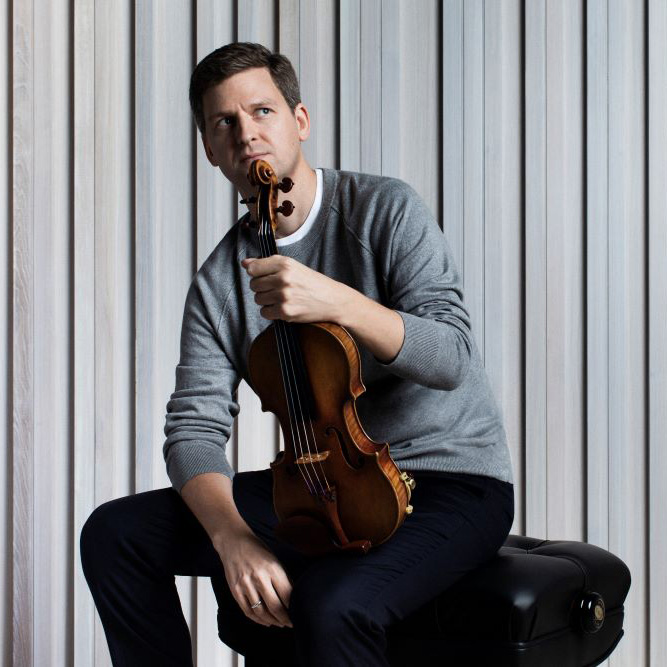
BRAHMS & DVOŘÁK
Valentina Peleggi | Conductor James Ehnes | Violin

Carlos Simon (1986 – ) | Fate Now Conquers | |
Johannes Brahms (1833 – 1897) | Violin Concerto in D Major, Op. 77 I. Allegro non Troppo II. Adagio III. Allegro Giocoso, ma non Troppo Vivace | |
INTERMISSION | ||
| Antonín Dvořák (1841 – 1904) | Symphony No. 8 in G Major, Op. 88 | |
Music Director Valentina Peleggi recently introduced the Richmond Symphony to Carlos Simon’s music, first featuring his work The Block. Simon, born in Washington, D.C., in 1986, is part of a new generation of composers shedding light on classical music from underrepresented perspectives. He has gained widespread recognition, currently holding the inaugural Composer Chair at the Boston Symphony and serving as composer-in-residence at the Kennedy Center.
In Fate Now Conquers, Simon turns his attention to the classical tradition, paying homage to Beethoven while maintaining his own artistic voice. The piece was commissioned by the Philadelphia Orchestra as part of a Beethoven symphony cycle marking the composer’s 250th anniversary in 2020, but the live performances were canceled due to the pandemic. The virtual premiere was conducted by Yannick Nézet-Séguin in October 2020.
The title Fate Now Conquers comes from a notebook entry of Beethoven’s dated 1815, in which he quotes a passage from Homer’s Iliad about fate conquering all, reflecting a time when Beethoven was grappling with personal challenges. For Simon, this image of Beethoven struggling with fate evoked the unpredictable nature of life. Musically, he portrays this through “jolting stabs” and “frenzied arpeggios” that dissolve into free-flowing passages, symbolizing life’s uncertainties.
Simon notes that Beethoven’s inclusion of the Iliad passage suggests that by the end of his life, the composer had relinquished himself to fate rather than fighting against it. In Fate Now Conquers, Simon seeks to convey both Beethoven’s struggle and his ultimate acceptance of fate.
Johannes Brahms: Violin Concerto in D Major, Op. 77
While Fate Now Conquers is often paired with Beethoven’s symphonies, Peleggi chose Johannes Brahms’ Violin Concerto in D Major to explore the broader Romantic idea of battling fate and emerging victorious. Brahms himself was deeply influenced by Beethoven, and his only violin concerto offers a fresh and unexpected synthesis of past and present.
Brahms composed the concerto during the summer of 1878 for his close friend, violinist Joseph Joachim. The work shares its key of D major with Beethoven’s Violin Concerto, and the two pieces echo each other in their grand first movements, lyrical second movements, and the prominent use of the violin’s high register.
Brahms took Beethoven’s ideas further, blending the soloist-ensemble interplay typical of concertos with the complex architecture of a symphony. Initially, Brahms envisioned the piece with four movements, akin to a symphony, but he later reduced it to three, reworking some material into his Second Piano Concerto. The first movement of the Violin Concerto is expansive and dramatic, marked by churning rhythms and wide-ranging figurations for the solo violin. After the orchestral introduction, the soloist enters with a dramatic soliloquy, and the music alternates between epic grandeur and lyrical beauty.
The second movement, Adagio, shifts to a radiant F major, offering an intimate dialogue between the solo violin and woodwinds. The violin’s lyrical flights are wrapped in warmth and tenderness, revealing new depths in the melody as the movement progresses.
The finale takes on a lively, dance-like character, paying tribute to Joachim’s Hungarian roots. Brahms employs virtuosic violin techniques—double stops, quick passagework, and dazzling chords—to evoke an earthy, folk-like energy. The movement blends moments of weightiness and drama with exuberant joy, culminating in an exuberant coda that recalls earlier themes with a new sense of triumph.
Antonín Dvořák: Symphony No. 8 in G Major, Op. 88
Peleggi draws a connection between Carlos Simon’s lyrical style and the melodic richness of Antonín Dvořák, whom Brahms admired for his gift of melody. Like Brahms, Dvořák found refuge in nature, composing many of his works during summer retreats to the countryside. In 1889, Dvořák wrote his Eighth Symphony while staying at his summer estate in Vysoká, near Prague. The symphony, infused with Czech folk influences, was first performed in Prague in 1890 and later introduced to Vienna by conductor Hans Richter, who praised it as a great work.
Dvořák’s Symphony No. 8 reflects his deep connection to the natural world, but it also showcases his personal voice and creative spirit. The first movement opens with a gentle, singing theme that carries a touch of melancholy before shifting to a brighter, more radiant G major. A flute melody reminiscent of birdsong introduces a pastoral atmosphere, while the brass section adds moments of dramatic intensity.
The second movement, Adagio, develops the themes introduced by the strings, blending serene and stormy moods. As the movement unfolds, Dvořák creates a rich tapestry of instrumental colors, using variations in orchestration to deepen the emotional impact.
Instead of a scherzo, Dvořák writes a graceful waltz for the third movement, tinged with sadness in G minor. This melancholy is countered by a sweet, playful section, offering a lighthearted contrast that stems from a comic opera Dvořák had written earlier in his career.
The symphony’s finale begins with trumpet fanfares, signaling the start of a lively and energetic exploration of the two-part theme introduced by the cellos. Dvořák builds the movement with a series of variations, recalling Beethoven’s Eroica and Brahms’ influence, while infusing the music with his unmistakable Czech style. The symphony concludes with a joyful, almost giddy coda, celebrating the vitality of life and nature.
Through the juxtaposition of Simon’s modern voice, Brahms’ Romantic struggles, and Dvořák’s pastoral lyricism, Peleggi’s program explores different responses to fate and the forces that shape our lives. The concert reflects the dynamic evolution of classical music, from Beethoven’s defiance to Simon’s homage, showcasing how composers across centuries grapple with the same universal themes.
(c)2024 Thomas May
